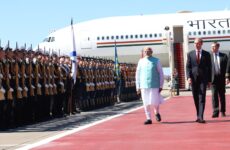New Delhi, The battle to conquer the throne of Delhi is not just being played out through public rallies, a fierce duel for the crown is being fought parallel on the virtual social media platforms between the contesting trio – AAP, BJP and Congress.
Social media has become the new battleground for political parties to unleash their election propaganda and assimilate young, technology-friendly voters into their fold.
Parties have well chalked out plans for tapping this sizable section of vote bank, through their formidable social media cells, an indispensable part of any party’s composition.
“We have a 16-member core team based in Delhi who handle the social media of the party. Another 55 members are operating from across the country and abroad. We have 200 active volunteers too,” said AAP’s social media coordinator Ankit Lal.
The three political rivals with over 26 lakhs Twitter followers and 1 crore Facebook likes between them are waging a war through hashtags, tweets, videos and Facebook posts.
Every party has a different strategy to handle the virtual war, similar to their different on-field manoeuvres.
The BJP with an army of 1,000 volunteers are engaged in rigorous promotion of their leaders’ messages on various social media platforms.
“The volunteers mostly working in IT companies and BPOs who have taken two weeks off from work and completely dedicated themselves to the online campaign,” said Delhi BJP’s communication cell convener Khem Chand Sharma.
“They promote the messages, schemes and policies that are in the BJP national website and also the messages of Kiran Bedi, Narendra Modi and Amit Shah,” he said.
AAP has an astute mechanism to handle the staggering number of online political aficionados which have resulted in garnering 23 lakhs likes on Facebook and over 11 lakh followers on Twitter.
A holistic, planned methodology is followed to spread the message of the AAP. Each medium is approached separately according to their strengths and characteristics.
“Facebook is a broadcast medium and hence the reach people is low. Too much of interaction isn’t possible, one can only suggest. Twitter is more organic, it is a more direct medium to engage in discussion, debate and reasoning. It is possible to change public perception through Twitter,” said AAP’s Lal.
News and issues of the day are the content of AAP’s tweets and the secret to their hashtags trending over other parties is attributed to the freedom allowed within the party.
“It’s a dynamic system that doesn’t look up to leadership for orders. It’s an inclusive process where posts and hashtags are volunteers’ decision,” Lal said.
The party also has a plan in place to to deal with trolls and hate comments. “A sensible argument on Twitter is answered and queries are replied to. For the comments beyond reasoning, there is no interaction,” he said.
Fairly new to the social media forum is Congress and that is reflected in its humble number of likes and followings on Facebook (35 lakhs) and Twitter (3 lakhs) compared to its arch rival BJP which flaunts 73 lakh likes on Facebook and 12 lakh followers on Twitter.
“A team of 12 people work on this front 24X7 and there are 70 volunteers dedicate around 7-8 hours working from their homes. The entire social media campaign of Congress is volunteer based,” said DPCC’s social media chairperson Radhika Khera.
The party uses the medium to further its offline tactics of propagate its policies, advertise its candidates and attack the opposition. Interestingly, the party shies away from interacting with virtual masses in case of malicious comments.
“We report such comments to the EC or to the respective website where such comments have appeared,” said Khera.
PTI




 Driving Naari Programme launched in Chandigarh
Driving Naari Programme launched in Chandigarh






























